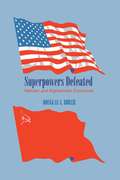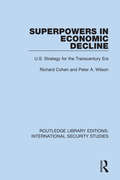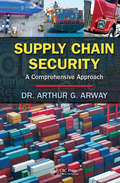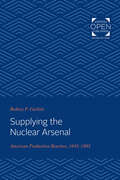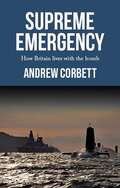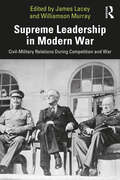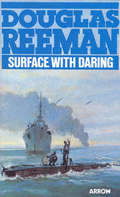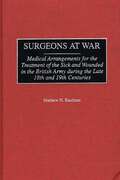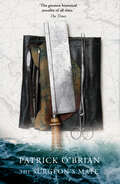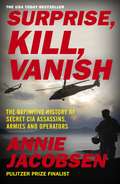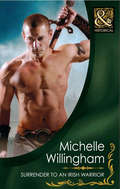- Table View
- List View
Supermarine Spitfire (large print)
by RnibThis page shows two images of an aircraft. At the top of the page seen from the side and in the bottom and middle of the page a plan view seen from above. There is a locator dot shown, which will be at the top left of the page when the image is the correct way up. Both views have the front on the left and the tail on the right of the page. The aircraft is shown in a flying position so the wheels are retracted and not shown. The aircraft in the top of the page has the propeller on the left with one blade pointing up and one pointing down. The nose cone is pale grey. Right from this is a rectangle which comprises six exhaust outlets. Down and right from the exhaust is the tip of the wing pointing towards you. The front edge on the left has a cannon sticking out. Up from the wing in the middle top of the fuselage is the cockpit cover shown as two windows. The centre of the fuselage has letters identifying which individual aircraft it is. There is also red and blue roundel indicating the plane belongs to the RAF. On the top edge of the fuselage there is an aerial sticking up. Right of this the fuselage continues to the vertical tail fin on the right. At base of the fin is the end of one of the tail wings. Right of this is a vertical flap. This is one of the ailerons used to manoeuvre the aircraft when it is flying. The tail has a red rectangle and a blue rectangle separated by a white line indicating the plane belongs to the RAF. In the plan view image in the bottom and middle of the page the fuselage goes from left to right in the centre of the image. The main wings go up and down the page from the fuselage. In the left of the page the propeller has one blade pointing up and one pointing down. The tip of the nose cone is pale grey. To the right of the propeller six exhaust outlets can be found on the top and bottom edge of the fuselage. Right of this are the wings. Each wing has two cannons mounted on the front edge. In the centre of each wing there is a red and blue roundel indicating the plane belongs to the RAF. On the right of each wing tip is a flap. These are two of the ailerons used to manoeuvre the aircraft when it is flying. In the centre of the fuselage between the wings is the cockpit shown as two windows. The fuselage continues to the right ending in the tailplane. On the right of each tail wing is a flap. These are two more of the ailerons used to manoeuvre the aircraft when it is flying.
Supermarine Spitfire (UEB contracted)
by RnibThis page shows two images of an aircraft. At the top of the page seen from the side and in the bottom and middle of the page a plan view seen from above. There is a locator dot shown, which will be at the top left of the page when the image is the correct way up. Both views have the front on the left and the tail on the right of the page. The aircraft is shown in a flying position so the wheels are retracted and not shown. The aircraft in the top of the page has the propeller on the left with one blade pointing up and one pointing down. The nose cone is pale grey. Right from this is a rectangle which comprises six exhaust outlets. Down and right from the exhaust is the tip of the wing pointing towards you. The front edge on the left has a cannon sticking out. Up from the wing in the middle top of the fuselage is the cockpit cover shown as two windows. The centre of the fuselage has letters identifying which individual aircraft it is. There is also red and blue roundel indicating the plane belongs to the RAF. On the top edge of the fuselage there is an aerial sticking up. Right of this the fuselage continues to the vertical tail fin on the right. At base of the fin is the end of one of the tail wings. Right of this is a vertical flap. This is one of the ailerons used to manoeuvre the aircraft when it is flying. The tail has a red rectangle and a blue rectangle separated by a white line indicating the plane belongs to the RAF. In the plan view image in the bottom and middle of the page the fuselage goes from left to right in the centre of the image. The main wings go up and down the page from the fuselage. In the left of the page the propeller has one blade pointing up and one pointing down. The tip of the nose cone is pale grey. To the right of the propeller six exhaust outlets can be found on the top and bottom edge of the fuselage. Right of this are the wings. Each wing has two cannons mounted on the front edge. In the centre of each wing there is a red and blue roundel indicating the plane belongs to the RAF. On the right of each wing tip is a flap. These are two of the ailerons used to manoeuvre the aircraft when it is flying. In the centre of the fuselage between the wings is the cockpit shown as two windows. The fuselage continues to the right ending in the tailplane. On the right of each tail wing is a flap. These are two more of the ailerons used to manoeuvre the aircraft when it is flying.
Supermarine Spitfire (UEB uncontracted)
by RnibThis page shows two images of an aircraft. At the top of the page seen from the side and in the bottom and middle of the page a plan view seen from above. There is a locator dot shown, which will be at the top left of the page when the image is the correct way up. Both views have the front on the left and the tail on the right of the page. The aircraft is shown in a flying position so the wheels are retracted and not shown. The aircraft in the top of the page has the propeller on the left with one blade pointing up and one pointing down. The nose cone is pale grey. Right from this is a rectangle which comprises six exhaust outlets. Down and right from the exhaust is the tip of the wing pointing towards you. The front edge on the left has a cannon sticking out. Up from the wing in the middle top of the fuselage is the cockpit cover shown as two windows. The centre of the fuselage has letters identifying which individual aircraft it is. There is also red and blue roundel indicating the plane belongs to the RAF. On the top edge of the fuselage there is an aerial sticking up. Right of this the fuselage continues to the vertical tail fin on the right. At base of the fin is the end of one of the tail wings. Right of this is a vertical flap. This is one of the ailerons used to manoeuvre the aircraft when it is flying. The tail has a red rectangle and a blue rectangle separated by a white line indicating the plane belongs to the RAF. In the plan view image in the bottom and middle of the page the fuselage goes from left to right in the centre of the image. The main wings go up and down the page from the fuselage. In the left of the page the propeller has one blade pointing up and one pointing down. The tip of the nose cone is pale grey. To the right of the propeller six exhaust outlets can be found on the top and bottom edge of the fuselage. Right of this are the wings. Each wing has two cannons mounted on the front edge. In the centre of each wing there is a red and blue roundel indicating the plane belongs to the RAF. On the right of each wing tip is a flap. These are two of the ailerons used to manoeuvre the aircraft when it is flying. In the centre of the fuselage between the wings is the cockpit shown as two windows. The fuselage continues to the right ending in the tailplane. On the right of each tail wing is a flap. These are two more of the ailerons used to manoeuvre the aircraft when it is flying.
Superpowers Defeated: Vietnam and Afghanistan Compared
by Douglas A. BorerDuring the Cold War, military conflicts in Vietnam and Afghanistan validated the importanct of war in global power dynamics. But military intervention proved not to be politically sustainable for the USA and the USSR. This study investigates the parallels and differences in the two conflicts.
Superpowers Defeated: Vietnam and Afghanistan Compared
by Douglas A. BorerDuring the Cold War, military conflicts in Vietnam and Afghanistan validated the importanct of war in global power dynamics. But military intervention proved not to be politically sustainable for the USA and the USSR. This study investigates the parallels and differences in the two conflicts.
Superpowers in Economic Decline: U.S. Strategy for the Transcentury Era (Routledge Library Editions: International Security Studies #20)
by Richard Cohen Peter A. WilsonThis book, first published in 1990, evaluates what future policy adjustments the US will have to make in order to successfully navigate through a national security environment radically altered from that of the past and one determined more than at any point in the post-war period by the economic performance of both superpowers. The structure of the book centres around two issues that will determine the future national security environment facing the US. Discussed are stakes of the threat, the response of the Soviet Union to the challenge of economic and related social/political decline and its implications for the Soviet national defence effort. Also studied are the resources available to the US to meet the threat, the status of the US economic performance and the magnitude of resource stress it is likely to face in the future and its probable impact on the US national defence effort.
Superpowers in Economic Decline: U.S. Strategy for the Transcentury Era (Routledge Library Editions: International Security Studies #20)
by Richard Cohen Peter A. WilsonThis book, first published in 1990, evaluates what future policy adjustments the US will have to make in order to successfully navigate through a national security environment radically altered from that of the past and one determined more than at any point in the post-war period by the economic performance of both superpowers. The structure of the book centres around two issues that will determine the future national security environment facing the US. Discussed are stakes of the threat, the response of the Soviet Union to the challenge of economic and related social/political decline and its implications for the Soviet national defence effort. Also studied are the resources available to the US to meet the threat, the status of the US economic performance and the magnitude of resource stress it is likely to face in the future and its probable impact on the US national defence effort.
Supply Chain Security: A Comprehensive Approach
by Arthur G. ArwayThe supply chain is a complex system of numerous, integrated stakeholders. These stakeholders are responsible for the transportation, storage, documentation, and handling of material goods and cargo. Each entity has its own unique relationship with and role within the chain as well as its own unique security requirements. The challenge of trying to
Supply Chain Security: A Comprehensive Approach
by Arthur G. ArwayThe supply chain is a complex system of numerous, integrated stakeholders. These stakeholders are responsible for the transportation, storage, documentation, and handling of material goods and cargo. Each entity has its own unique relationship with and role within the chain as well as its own unique security requirements. The challenge of trying to
Supplying the Nuclear Arsenal: American Production Reactors, 1942-1992
by Rodney P. CarlisleAlthough the history of commercial-power nuclear reactors is well known, the story of the government reactors that produce weapons-grade plutonium and tritium has been shrouded in secrecy. In the first detailed look at the origin and development of these production reactors, Rodney Carlisle and Joan Zenzen describe a fifty-year government effort no less complex, expensive, and technologically demanding than the Polaris or Apollo programs—yet one about which most Americans know virtually nothing.
Supreme emergency: How Britain lives with the Bomb
by Andrew CorbettIn Supreme emergency, an ex-Trident submarine captain considers the evolution of UK nuclear deterrence policy and the implications of a previously unacknowledged aversion to military strategies that threaten civilian casualties. Drawing on extensive archival research, the book provides a unique synthesis of the factors affecting British nuclear policy decision-making and draws parallels between government debates about reprisals for First World War zeppelin raids on London, the strategic bombing raids of the Second World War and the evolution of the UK nuclear deterrent. It concludes that among all the technical factors, an aversion to being seen to condone civilian casualties has inhibited government engagement with the public on deterrence strategy since 1915.
Supreme emergency: How Britain lives with the Bomb
by Andrew CorbettIn Supreme emergency, an ex-Trident submarine captain considers the evolution of UK nuclear deterrence policy and the implications of a previously unacknowledged aversion to military strategies that threaten civilian casualties. Drawing on extensive archival research, the book provides a unique synthesis of the factors affecting British nuclear policy decision-making and draws parallels between government debates about reprisals for First World War zeppelin raids on London, the strategic bombing raids of the Second World War and the evolution of the UK nuclear deterrent. It concludes that among all the technical factors, an aversion to being seen to condone civilian casualties has inhibited government engagement with the public on deterrence strategy since 1915.
Supreme Leadership in Modern War: Civil-Military Relations During Competition and War (Cass Military Studies)
by James Lacey Williamson MurrayThis edited volume focuses on civil-military relations before and during great power conflicts, and comprises historical case studies of modern supreme leadership. It aims to provide a guide for the future by shining a light on what worked and what failed in the civil-military relationships that steered great powers during the last era of rapid global change. While future civil-military relationships will have to adapt to the current global environment, the past remains, as always, a prelude. Thus, crucial concepts that underpin all such relationships are eternal and are waiting to be drawn out by historians trained to examine and present them to those who can put them to immediate good use. This volume demonstrates the relevance of history in every chapter, as readers will see parallels to today’s problems throughout every case study. The world is entering an age of great challenges, many of which require nations – particularly the most powerful – to establish civil-military relationships capable of navigating dangerous currents without a repeat of the calamities reminiscent of the last century. Each chapter focuses on a particular civil-military relationship as it developed before and during a great war. The editors have gathered leading experts on each of these periods to produce a concise but thorough essay on each relationship's intricacies. This book will be of much interest to students of military and strategic studies, military history and international relations, as well as professional miliary colleges and policymakers.
Supreme Leadership in Modern War: Civil-Military Relations During Competition and War (Cass Military Studies)
This edited volume focuses on civil-military relations before and during great power conflicts, and comprises historical case studies of modern supreme leadership. It aims to provide a guide for the future by shining a light on what worked and what failed in the civil-military relationships that steered great powers during the last era of rapid global change. While future civil-military relationships will have to adapt to the current global environment, the past remains, as always, a prelude. Thus, crucial concepts that underpin all such relationships are eternal and are waiting to be drawn out by historians trained to examine and present them to those who can put them to immediate good use. This volume demonstrates the relevance of history in every chapter, as readers will see parallels to today’s problems throughout every case study. The world is entering an age of great challenges, many of which require nations – particularly the most powerful – to establish civil-military relationships capable of navigating dangerous currents without a repeat of the calamities reminiscent of the last century. Each chapter focuses on a particular civil-military relationship as it developed before and during a great war. The editors have gathered leading experts on each of these periods to produce a concise but thorough essay on each relationship's intricacies. This book will be of much interest to students of military and strategic studies, military history and international relations, as well as professional miliary colleges and policymakers.
Surface With Daring
by Douglas ReemanHiding, lying in wait on the sea bed, is EX16, one of the most important ships in the Royal Navy. She's not much to look at, and she's only 54 feet long, with no defensive armament. But her four-man crew knows that the outcome of the war could depend on this midget submarine. Seaton, her commander, understands what his men face. There is the boredom, the discomfort, the jealousy and bickering; and already they have confronted enormous dangers on desperate raids into Norway. Now, poised for the attack on a secret Nazi rocket installation, Seaton must hold his crew together for the hell that awaits them-
Surgeons at War: Medical Arrangements for the Treatment of the Sick and Wounded in the British Army during the late 18th and 19th Centuries (Contributions in Military Studies)
by Matthew KaufmanKaufman examines the training and status of British military surgeons during the late 18th and 19th centuries. Their management of the sick and wounded during the wars with France leading up to and including the Peninsular War is also described. He concludes with an analysis of the medical problems associated with the Crimean War.Using important contemporary texts, Kaufman describes the personalities who served in the British Army Medical Department during the late 18th and 19th centuries, when diseases caused a much higher mortality than injuries sustained in battle. Many military surgeons were only poorly trained, and the management of the sick and wounded only gradually improved over this period despite significant advances in medicine, surgery, and hygene. Government spending cuts after the Peninsular War greatly depleted the medical service of the army so that by the time of the Crimean War it was unable to cope with a European-style war. Deficiencies were recognized and, in the case of the medical services, this led to the establishment of the Army Medical School in 1860. This analysis should be of particular interest to serving military medical officers and to historians and other researchers interested in the management of 18th and 19th century armies in times of peace and war.
The Surgeon's Christmas Baby: The Cowboy Seal's Jingle Bell Baby The Surgeon's Christmas Baby (Cowboys of the Rio Grande #2)
by Marin ThomasUNEXPECTED FAMILY…
The Surgeon's Convenient Husband: The Sheikh Doc's Marriage Bargain / The Surgeon's Convenient Husband (Mills And Boon Medical Ser. #Vol. 1030)
by Amy RuttanSurprise reunion… …with her husband!
The Surgeon’s Mate (Aubrey/Maturin Series #7)
by Patrick O’BrianPatrick O’Brian’s Aubrey-Maturin tales are widely acknowledged to be the greatest series of historical novels ever written. Now, for the first time, they are available in electronic book format, so a whole new generation of readers can be swept away on the adventure of a lifetime. This is the seventh book in the series.
The Surplus Girls: An enthralling saga of love and bravery, perfect for fans of Lyn Andrews and Lily Baxter
by Polly HeronAfter the loss of war, can there be hope for the future?Manchester, 1922.Belinda Layton is a surplus girl. One of the many women whose dreams of marriage perished in the Great War, with the death of her beloved fiancé, Ben. After four years of mourning, she's ready to face the future, even though Ben's family is not happy to see her move on, and her own only cares about getting hold of her meagre factory wages. Then, Belinda joins a secretarial class and a whole new world opens up to her as she quickly finds herself drawn to beguiling bookshop owner Richard Carson. But after all the loss and devastation she has experienced, can she really trust him with her heart?
The Surplus Girls Books 1-3: An enthralling saga of love and bravery, perfect for fans of Lyn Andrews and Lily Baxter
by Polly HeronThe Surplus Girls Belinda Layton is a surplus girl. One of the many women whose dreams of marriage perished in the Great War, with the death of her beloved fiancé, Ben. After four years of mourning, she's ready to face the future, even though Ben's family is not happy to see her move on, and her own only cares about getting hold of her meagre factory wages. Then, Belinda joins a secretarial class and a whole new world opens up to her as she quickly finds herself drawn to beguiling bookshop owner Richard Carson. But after all the loss and devastation she has experienced, can she really trust him with her heart?The Surplus Girls' OrphansMolly Watson has had enough. Engaged for the last three years to a penny-pinching pedant, she finally decides she'd rather be a surplus girl than marry a man she doesn't truly love. When she gets a job at St Anthony's Orphanage, she befriends caretaker Aaron Abrams. But a misunderstanding leaves them at loggerheads, and damages her in the eyes of the children she has come to care so deeply about. Can she recover her reputation, her livelihood, and her budding friendship, before it's too late?Christmas with the Surplus GirlsNancy Pike is out of her depth at Miss Hesketh's school for surplus girls, blundering through her lessons and her job placements. Her only joy is getting to know the children at St Anthony's orphanage. And working for Mr Zachary Milner twice a week. Alone in the world since the death of his brother, Nancy's presence has brought a little sunshine back into Zachary's life. But when she makes a terrible mistake that puts his livelihood in jeopardy, he has no choice but to let her go. As she battles the prejudices around her, and her own fear, Nancy is determined to bring some Christmas cheer to the orphanage - and maybe even to Zachary Milner...
The Surplus Girls' Orphans (Surplus Girls)
by Polly HeronManchester, 1922Molly Watson has had enough. Engaged for the last three years to a penny-pinching pedant, she finally decides she'd rather be a surplus girl than marry a man she doesn't truly love. Aware of the need to support herself if she is to remain single all her life, she joins a secretarial class to learn new skills, and a whole world opens up to her.When she gets a job at St Anthony's Orphanage, she befriends caretaker Aaron Abrams. But a misunderstanding leaves them at loggerheads, and damages her in the eyes of the children she has come to care so deeply about. Can she recover her reputation, her livelihood, and her budding friendship, before it's too late?
Surprise Attack: The Victim's Perspective, With a New Preface
by Ephraim KamEphraim Kam observes surprise attack through the eyes of its victim in order to understand the causes of the victim’s failure to anticipate the coming of war. Emphasizing the psychological aspect of warfare, Kam traces the behavior of the victim at various functional levels and from several points of view in order to examine the difficulties and mistakes that permit a nation to be taken by surprise. He argues that anticipation and prediction of a coming war are more complicated than any other issue of strategic estimation, involving such interdependent factors as analytical contradictions, judgmental biases, organizational obstacles, and political as well as military constraints.
Surprise, Kill, Vanish: The Definitive History of Secret CIA Assassins, Armies and Operators
by Annie JacobsenSince 1947, domestic and foreign assassinations have been executed under the CIA-led covert action operations team. Before that time, responsibility for taking out America's enemies abroad was even more shrouded in mystery. Despite Hollywood notions of last-minute rogue-operations and external secret hires, covert action is actually a cog in a colossal foreign policy machine, moving through, among others, the Bureau of Intelligence and Research, the House and Senate Select Committees. At the end of the day, it is the President, not the CIA, who is singularly in charge.When diplomacy fails and overt military action is not feasible, the President often calls on the Special Activities Division, the most secretive and lowest-profile branch of the CIA. It is this paramilitary team that undertakes dramatic and little-known assignments: hostage rescues, sabotage, and, of course, assassinations. For the first time, Pulitzer Prize finalist and New York Times bestselling author Annie Jacobsen takes us deep inside this top-secret history. With unparalleled access to former operatives, ambassadors, and even past directors of the Secret Service and CIA operations, Jacobsen reveals the inner workings of these teams, and just how far a U.S. president may go, covertly but lawfully, to pursue the nation's interests.
Surrender to an Irish Warrior: Her Irish Warrior The Warrior's Touch Her Warrior King Her Warrior Slave Surrender To An Irish Warrior (The MacEgan Brothers #6)
by Michelle WillinghamAN IRISH WARRIOR WITH A THIRST FOR REVENGE… Trahern MacEgan – his body is honed for fighting, his soul is black and tortured. Women want to tame him, but he has loved once, and now is lost.

